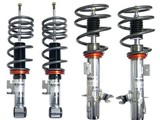|
Better Handling for Road, Track or Autocross by Gary Anderson and Don Racine
In the second section of this book, we were particularly complimentary regarding the MINI’s stock suspension, noting that it will reward a good driver and can be well down the priority list of things to work on for improved performance. Now, with a few days of track time under your belt, or maybe a day or two out on the autocross course, and lots of corners that you have been practicing to go around just right, you may be ready to consider tweaking the suspension a bit for better handling performance. Once again we’re back to trade-offs. For the average driver, with average passengers, the ability of the car to absorb bumps without rattling the dentures of gran’pa in the back seat is at least as important as how fast the car will get around corners. As a result, when designing the shocks, springs, and suspension on any car, engineers are going to err at least slightly on the side of a soft ride. The trade-off is that the car will lean more when going around corners. In the interests of improving your potential to get around corners, you may want to think about changing the trade-off, so that the car may not ride as softly going over bumps, but it will lean less going around corners. To do this, you’ll want to consider replacing the springs, upgrading the shocks, adding a rear sway bar, and changing the rear control arms. Each of these suspension modifications can be installed separately, if your budget is limited, and they can be installed in the order in which they’re discussed. If you can swing the expense, you can save money and gain maximum improvements in handling, by installing all the components at the same time. Performance Spring Kit and Shock Upgrades
The Mini Cooper S, with its sport suspension (optional on the Mini Cooper) does use heavier (less-resilient) springs with a bit less travel, but the engineers are still assuming you just want good street handling, and aren’t going to want to go a little fast in the twisty bits or take the car on a track or autocross course. For these purposes, a stiffer spring and lower ride height will be in order. With a stiffer spring, the car won’t cushion you as much on the bumps, but more important, it won’t sway as much on corners, or shift back and forth as much on acceleration and braking. With a shorter spring, the center of gravity will be a little lower, also reducing the amount of side-to-side or front-to-rear body roll. Good high-performance spring kits are readily available in the aftermarket. These improved spring kits will help your car maintain its stability when starting, stopping, and turning without wallowing around. These kits won’t make your car ride so rough that your passengers will complain, but they will definitely increase the predictability of the car in the corners and help reduce your lap times. A typical upgraded spring kit sells for less than $250. While most of the good performance spring kits will work with the original equipment shocks, you might want to consider upgrading your shock absorbers at the same time. The shock absorbers work together with your springs so that the car doesn’t just bounce up and down and up and down every time it sways or hits a bump. Actually, the term “shock absorber” isn’t quite accurate, since the springs actually absorb the shocks from uneven road surfaces, while the shock absorbers help counter the effect of the springs. The English call them “dampers” which is a more accurate term. The shock absorbers in the MINI are long tubes that are installed between the wheel and the chassis in parallel with the springs. Inside the outer tube is a piston with a special valve that allows fluid to move from the main tube into the piston as the shock absorber compresses and then move back into the main tube at a slower rate when the shock absorber extends. The shock absorber works by compressing easily when the spring compresses, but then reducing the rate at which the spring expands. So, instead of continuing to oscillate up and down as it would if only the spring were in between the chassis and wheel, the chassis comes back to a neutral position after only one or two movements. Like original equipment springs, original equipment shocks are designed to do their job with emphasis on comfort, rather than performance. They damp the spring movement just enough to avoid making passengers seasick, but not enough to give a harder ride. To improve your handling, you’ll want even less oscillation so that the car will return to a neutral position more quickly. By installing performance shocks, you still get some springing action to absorb the bumps and weight changes, but the car will move less and return to neutral more quickly after acceleration or braking, or in between corners. A set of performance shocks designed specifically for the MINI, such as the one by Koni, is a good complement to shorter, stiffer performance springs. One MINI aftermarket catalog offers the Koni shocks for front and rear for a total of about $690, or the combination of performance springs and Koni shocks for a total of $875. Spax makes a set of “coil-over” shocks that are an alternative to replacing the springs and shocks separately. With this kit, performance springs are wrapped around the shocks, hence the name, and the combined spring and shock is mounted after removing both the stock spring and stock shock at each corner. This alternative is more expensive that installing springs and shocks separately, typically selling for about $1300. Coil-over kits can certainly be used to improve the handling on street cars. However, they are more likely to be installed by owners who expect to use their MINI frequently on the track or autocross course, since they are available in different spring rates and do offer the means to adjust ride height at each corner. Different spring rates will be appropriate, depending on the experience of the driver and the frequency with which the car will be used in competition. Springs that are closer to stock firmness will be appropriate for the person who doesn’t compete too often, and also wants to use the car for street use. On the other hand, if the MINI is only going to be used for competition and the driver is quite experienced, the preference will be for a much firmer spring. By adjusting the ride height at each corner, the owner can balance corner weights to compensate for other changes that have been made in the car, since balance is very important in tuning the car’s handling for the race track. Ride Height, Camber and Toe “Camber” is the angle of the wheel when compared with a vertical line, when the car is resting on its springs. If the top of the wheel leans in towards the car when the car is sitting still, we say that the wheel has “negative camber.” On the other hand, if the top of the tire leans out when the car is sitting still, that would be “positive camber.”
The extent to which the tires toe in or toe out determines how easy it is to get the car to turn. With toe-out, the car would want to go straight rather than turn, with toe-in, the car will turn more easily. Two methods exist to change rear toe-in: you can use a rear camber/toe kit to replace some of the rear suspension fasteners, or you can replace the stock rear control arms with adjustable control arms. The rear camber/toe kit is less expensive than the adjustable control arms, but the adjustable control arms give you a little more control of rear camber and toe and are easier to adjust. Rear Camber/Toe Kit Adjustable Rear Control Arm Kit However, the stock control arms are not adjustable. The factory set-up can be changed by modifying the control arms mounting points, but the range of adjustment is limited, and adjustment isn’t easy to do. To permit a wider range of adjustment in camber and toe, and to make the adjustment easier, aftermarket suppliers make adjustable control arms that replace the stock control arms on the rear suspension. With these rear control arms installed, it is possible to adjust the camber and toe of the rear wheels after performance springs and shocks are installed. The control arms are adjusted so that the wheels will have a slight amount of toe-in and a slight amount of negative camber. The toe-in adjustment reduces the car’s tendency to understeer by allowing the rear wheels to turn more easily, and the negative camber assures that as much tire tread as possible is in contact with the pavement during cornering. Rear control arms are available for about $495. They can be installed easily and with little additional expense if they are installed at the same time that high-performance springs and shocks are installed. It doesn’t make sense to install the control arms before installing modified springs and shocks, but they can also be installed at any time after the springs and shocks have been installed to allow additional suspension tuning. MINI Cooper sway Bars to Reduce Understeer Front and Rear Strut Brace Kits  However, as you start to drive the car harder, on track days or around the autocross cones, or just like tossing it around back roads corners, you might want to stiffen up the chassis just a bit more. This upgrade is one of the easiest in this book. It is accomplished simply by bolting a “strut brace” across the front of the car in the engine compartment, to connect the tops of the two front strut towers to one another. However, as you start to drive the car harder, on track days or around the autocross cones, or just like tossing it around back roads corners, you might want to stiffen up the chassis just a bit more. This upgrade is one of the easiest in this book. It is accomplished simply by bolting a “strut brace” across the front of the car in the engine compartment, to connect the tops of the two front strut towers to one another.The benefit of this brace is to stiffen the front of the car to reduce flex in the suspension. Where the stock MINI feels pretty stiff and strong in corners, the added strut brace makes it feel really solid so that the car turns into the corners more easily without hesitation. Of course, since the brace is visible to anyone looking in the engine compartment and is an attractive accessory, it certainly adds to the performance credibility of the car. A stiff, well-constructed strut brace is desirable on a car that is running with low-profile, high-performance tires and especially desirable when installed in conjunction with a lowered suspension. A typical well-engineered strut brace will cost about $325, and can easily be installed by anyone with the right-sized wrenches in less than an afternoon. Chassis stiffness becomes increasingly important as the MINI is used more often for serious autocrossing, and is an important element in suspension tuning. For this reason, many tuners also prefer to add a rear strut brace to the MINI before making other changes to the rear suspension of the car. Like the front suspension, this additional component is bolted on to the rear suspension mounts and extends across the car. A good rear strut brace can be purchased for about $200 and is easily installed.
Typical Suspension Upgrade Prices
On the other hand, because the components do have an effect on one another, and each works better when the others are installed, the alternative strategy of installing them all at once is preferable, if you can manage it. In fact, because the various adjustments and upgrades to the suspension work best when all are in place, several suppliers offer suspension upgrade kits that include most or all of the components we’ve discussed, at a lower price than if the components are bought separately. For example, all the suspension upgrades suggested here, including shorter, heavier springs, adjustable shocks, rear sway bar, and rear control arms, plus the front and rear strut braces, can be purchased from MiniMania as a single kit. The complete MiniMania, “high-performance suspension upgrade kit” currently sells for for about $2000. Of course, installation costs also are significantly reduced if all the components are installed at the same time.
|
||
    |
Better Handling on the Road, Track or Autocross For your MINI
Let's make sure we're showing you the right parts! Please Select your car type Below:







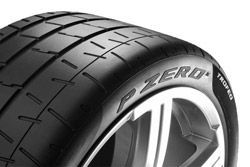
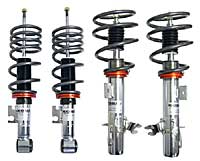
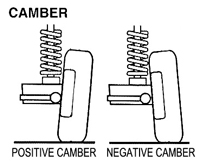
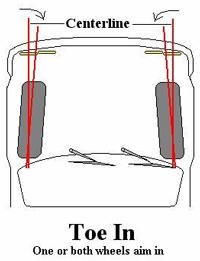 full width of the tread will still be in contact with the pavement throughout the turn.
full width of the tread will still be in contact with the pavement throughout the turn.

